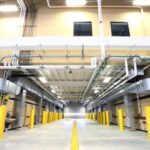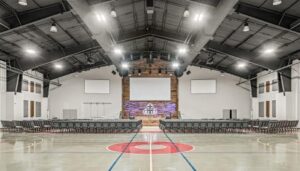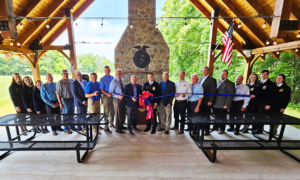Location: Ft. Campbell, Ky.
Size: 35,290 sq. ft.
Size: 35,290 sq. ft.
Complete: September 2013
Owner: U.S. Army Corps of Engineers
Owner: U.S. Army Corps of Engineers
J&S Construction completed construction of a $12.2 million contract, building a Vehicle Maintenance Facility for the U.S. Army Corps of Engineers, Louisville District.
The 35,290 square-foot Vehicle Maintenance Facility (VMF) was completed September 2013, and was constructed for the 101st Combat Aviation Brigade at Ft. Campbell, Ky. The complex consists of a Tactical Equipment Maintenance Facility (TEMF), Organizational Storage Building (OSB), Hazardous Waste Storage Building (HWSB), Petroleum Oil and Lubricant storage building (POL), Tactical Unmanned Aerial Vehicle storage building (TUAV), organization vehicle hardstand and privately owned vehicle parking.
This facility was designed/constructed to meet LEED Silver Certification requirements; environmentally friendly features include transpired solar wall panel system, skylights, daylighting tubes, spray foam insulation, air barrier system, radon piping system, low flow water fixtures, energy recovery units, in-floor radiant heating system, occupancy sensors, low VOC and recycled materials.
These facility types are used for the purpose of maintaining and repairing vehicles, complete with equipment and parts storage and administrative offices. J&S Construction completed its first TEMF in August 2010, a $13 million project which resulted in an outstanding rating by USCAE for performance, as well as marking the first LEED Gold Certification at the USACE’s Ft. Campbell base and for the Louisville District.
“We are once again very pleased and excited to have been chosen by the U.S. Army Corps of Engineers to be involved in the construction of facilities for the men and women who help protect us and make our country great,” said Jack Stites, J&S Construction CEO. “The high standards the Corps continues to use in measuring performance is just another tool J&S can utilize to help improve all projects we complete, whether it be government contracts or in the private sector.”
114,500 man-hours were logged for this project, including 9,500 equipment-operating hours logged with no lost-time accidents.
The 35,290 square-foot Vehicle Maintenance Facility (VMF) was completed September 2013, and was constructed for the 101st Combat Aviation Brigade at Ft. Campbell, Ky. The complex consists of a Tactical Equipment Maintenance Facility (TEMF), Organizational Storage Building (OSB), Hazardous Waste Storage Building (HWSB), Petroleum Oil and Lubricant storage building (POL), Tactical Unmanned Aerial Vehicle storage building (TUAV), organization vehicle hardstand and privately owned vehicle parking.
This facility was designed/constructed to meet LEED Silver Certification requirements; environmentally friendly features include transpired solar wall panel system, skylights, daylighting tubes, spray foam insulation, air barrier system, radon piping system, low flow water fixtures, energy recovery units, in-floor radiant heating system, occupancy sensors, low VOC and recycled materials.
These facility types are used for the purpose of maintaining and repairing vehicles, complete with equipment and parts storage and administrative offices. J&S Construction completed its first TEMF in August 2010, a $13 million project which resulted in an outstanding rating by USCAE for performance, as well as marking the first LEED Gold Certification at the USACE’s Ft. Campbell base and for the Louisville District.
“We are once again very pleased and excited to have been chosen by the U.S. Army Corps of Engineers to be involved in the construction of facilities for the men and women who help protect us and make our country great,” said Jack Stites, J&S Construction CEO. “The high standards the Corps continues to use in measuring performance is just another tool J&S can utilize to help improve all projects we complete, whether it be government contracts or in the private sector.”
114,500 man-hours were logged for this project, including 9,500 equipment-operating hours logged with no lost-time accidents.


















